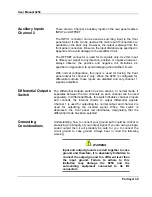
User Manual 9250
Portrayal 1-7
generate an output of 20Vp-p. On the other hand, if
you increase your load impedance by a large
factor, the output will increase by a factor of:
Vout = 40Vp-p - 40Vp-p x 50
Ω
/ (50
Ω
+X
Ω
)
where X = your load impedance
If you look at the equation above, with exactly 50
Ω
load impedance, the output will be 20Vp-p and as
you increase the load impedance, the output
increases proportionally until, at very high load
impedance, the output is doubled to 40Vp-p.
40Vp-p is the maximum amplitude level this amplifier can produce
however, only into high impedance loads.
WARNING
Applying the output signal on inductive or
capacitive loads may damage the amplifier.
Front Panel
Indicators
The 9250 has 2 indicators on its front panel. The POWER LED will
light as soon as you press the switch to power up the 9250. An
illuminated power light designates power is applied to the
instrument and you should expect to have signal at its output
connector(s).
An LED at the center of the front panel is marked Differential ON.
When this light is on, channel 2 input is disabled and signal applied
to the channel 1 input is routed to both channel 1 and channel 2
outputs, except the signal is now differential. The differential mode
is selected with a rear panel switch.
Rear Panel Parts
and Connectors
The rear panel is rarely used for normal operation however, there
are some connections you must do before you can operate the
amplifier for example, connecting the mains power to the
instrument. There are other connectors and parts on the rear panel;
These are discussed in the following paragraphs. Refer to Figure 1-
2 throughout the following description.















































